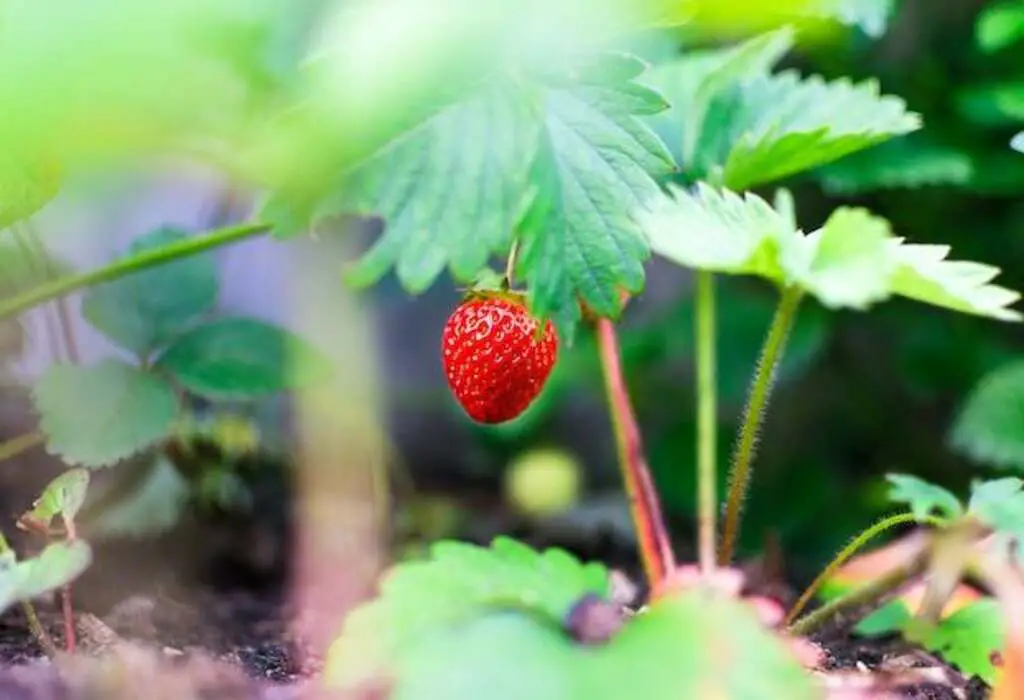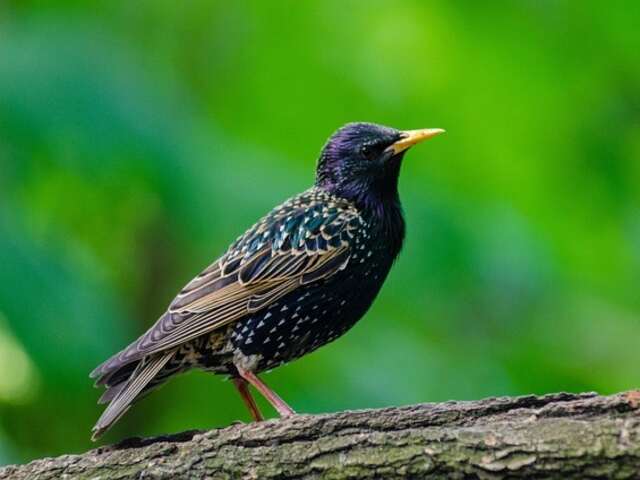
Birds can be a significant threat to strawberry plants, as they are attracted to the sweet and juicy fruit that these plants produce.
Many different bird species can damage strawberry plants, including robins, sparrows, starlings, and blackbirds. These birds can peck at the fruit, eat the berries, or pull the entire plant out of the ground.
Therefore, it is essential to take measures on how to protect strawberry plants from birds. Fortunately, there are many effective ways to keep birds away from strawberry plants.
Some methods involve physical barriers, such as netting or cages, while others use deterrents that scare birds away, such as reflective tape or predator decoys.
Additionally, there are natural ways to keep birds away from strawberry plants, such as planting certain types of plants or using homemade remedies.
By implementing these strategies, you can help ensure that your strawberry plants are safe from bird damage and produce a bountiful harvest.
Table of Contents
- 1 Types of Birds That Damage Strawberry Plants
- 2 How To Protect Strawberry Plants From Birds Effectively?
- 3 Natural Ways To Keep Birds Away from Strawberry Plants
- 4 Best Time to Apply Bird Deterrent Methods
- 5 Frequently Asked Questions
- 5.1 What other types of animals besides birds can damage strawberry plants?
- 5.2 Are there any bird species that are not deterred by common bird deterrent methods?
- 5.3 How often should bird deterrent methods be applied to strawberry plants?
- 5.4 Can bird netting be used on other types of fruit plants besides strawberries?
- 5.5 Are there any potential negative effects on the environment or other wildlife from using bird deterrent methods?
- 6 Conclusion
- 7 Author
Types of Birds That Damage Strawberry Plants
Various avian species are known to cause substantial harm to strawberry crops, resulting in significant economic losses for farmers and growers.
Birds such as American robins, European starlings, and cedar waxwings are among the most common types of birds that damage strawberry plants.
These birds cause damage by consuming the fruit, pecking at the berries, and pulling them apart.
They also damage the plants by pulling out the leaves and stems, which can lead to stunted growth and a reduced yield.
To prevent crop damage from birds, it is important to understand their behavior and habitats.
Bird guides and bird food suppliers can provide valuable information on the types of birds that are common in your area, as well as their feeding habits and preferred habitats.
With this information, farmers and growers can take proactive measures to protect their crops from birds, including using bird netting, bird scare devices, and other bird supplies.
Effective ways to keep birds away from strawberry plants include using reflective tape, scarecrows, and decoys.
| Bird Species | Additional Information |
|---|---|
| American Robin | Known to feed on ripening strawberries |
| Northern Mockingbird | May damage strawberries during fruit development |
| Cedar Waxwing | Can consume strawberries and other fruits |
| Blue Jay | Known to eat strawberries and cause damage |
| European Starling | Commonly feed on ripe strawberries |
| Sparrow | Can cause significant crop damage |
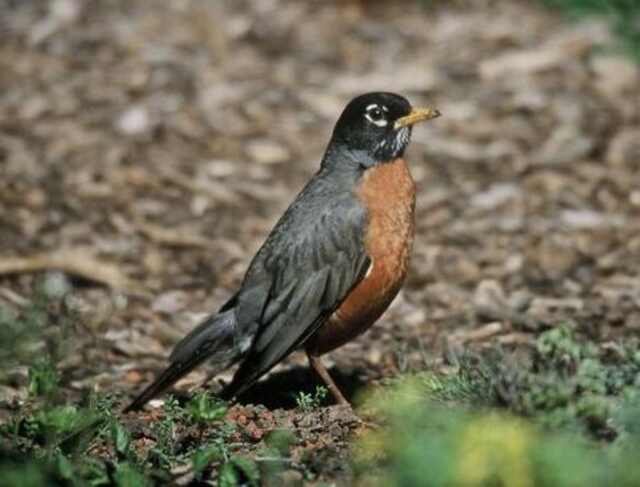
How To Protect Strawberry Plants From Birds Effectively?
There are various effective ways to keep birds away from strawberry plants.
These methods include the use of netting, scarecrows, reflective tapes, and noise-making devices.
Each method has its own advantages and disadvantages, and it is essential to carefully consider which method is best suited for one’s needs.
Netting Method
The implementation of netting as a preventative measure demonstrates a viable option for deterring avian species from accessing and potentially damaging crops, such as strawberry plants.
Bird netting is a common and effective method used by farmers and gardeners to protect their fruits from birds.
The netting method involves covering the plants with a fine mesh that prevents birds from reaching the fruit.
Bird netting is an essential tool that can significantly reduce the number of birds that damage the fruit set of strawberry plants.
The netting method is a safe and humane option that does not harm the birds, and it can be used for extended periods.
However, it is vital to ensure that the netting is installed correctly to avoid birds becoming trapped or entangled.
In the next section, we will discuss another method for protecting strawberry plants from birds, the scarecrow method.
Table: Netting Method
| Netting Method | Details |
|---|---|
| Netting material | Type of material used for bird netting |
| Netting size | Size specifications for the netting |
| Poles or support structure | Components used to support and secure the netting |
| Durability | Longevity and resistance of the netting material |
Scarecrow Method
The Scarecrow method is a commonly used technique for minimizing avian crop damage, with studies showing that birds can cause up to 20% of crop losses worldwide.
For farmers who grow strawberries, birds that pose a threat to these plants include the American Robin, Cedar Waxwing, and European Starling, which all have aggressive feeding habits that can reduce yields.
To deter these birds, a scarecrow can be constructed using materials such as straw, old clothes, and a pole, which is placed in the middle of the strawberry patch.
The scarecrow’s main function is to trick birds into thinking a human presence is there to protect the plants. As a result, birds may avoid the area altogether, leaving farmers with an increased yield.
Although the scarecrow method has been used for centuries, it is still a viable option for farmers today.
With advancements in technology, scarecrows can be constructed using materials that are more durable and long-lasting.
However, some farmers have found that birds eventually become accustomed to the presence of a scarecrow and return to their aggressive feeding habits.
In these cases, farmers may need to supplement the scarecrow method with additional techniques, such as the reflective tape method, which will be discussed in the subsequent section.
Table: Scarecrow Method
| Scarecrow Method | Details |
|---|---|
| Human figure | Representation of a human to scare away birds |
| Bird repellent devices | Devices designed to repel birds from the strawberry plants |
Reflective Tape Method
The Reflective Tape Method is a widely used technique for deterring avian crop damage that relies on the reflective properties of tape to create a perceived threat to birds.
This method involves the use of reflective objects, such as strips of aluminum foil or reflective tape, tied to stakes or poles near the strawberry plants.
The reflective surfaces create visual distractions that scare away birds as they approach the plants.
To effectively use the Reflective Tape Method, it is essential to follow these three steps:
- Place reflective tape or other reflective objects around the perimeter of the strawberry patch to create a visible barrier for birds.
- Use enough reflective tape to ensure that birds can see the tape from a distance.
- Move the reflective tape around the strawberry patch as needed to prevent birds from becoming accustomed to the visual deterrent.
The Reflective Tape Method is an effective and relatively inexpensive bird repellent that can help protect strawberry plants from damage.
However, there are other methods, such as the noise-making method, that can also be used in combination with reflective tape for increased effectiveness.
Table: Reflective Tape Method
| Reflective Tape Method | Details |
|---|---|
| Shiny tape | Reflective tape or material used as a visual deterrent |
| Plant placement | Strategic positioning of plants in relation to the tape |
| Barrier coverings | Additional coverings or barriers used in conjunction |
Noise-Making Method
The Noise-Making Method is a widely recognized technique aimed at deterring bird damage, utilizing audible distractions to create a perceived threat to avian life.
Gardeners can implement this method using various types of noise-making equipment, including wind chimes, bells, and even recorded bird distress calls.
These sounds are aimed at creating an uncomfortable environment for birds, disrupting their feeding patterns and deterring them from coming back for more.
Some types of birds that can cause damage to strawberry plants include robins, sparrows, and starlings.
These birds are attracted to the bright red color of ripened strawberries and will often peck at them, ruining the fruit.
While physical barriers such as netting can be effective, the noise-making method is an alternative that can be less intrusive to the garden.
By using this method, gardeners can create a more dynamic and innovative approach to protecting their strawberry plants from bird damage.
Transitioning into the subsequent section about ‘natural ways to keep birds away from strawberry plants,’ there are also other methods that gardeners can use to deter birds from their crops.
Table: Noise-Making Method
| Noise-Making Method | Details |
|---|---|
| Acoustic tactics | Techniques involving sounds or noises to deter birds |
| Aluminum foil strips | Strips of aluminum foil used to create noise and movement |
| CDs | Discs that produce noise and reflections |
| Motion-activated water sprayers | Sprayers triggered by motion to startle birds |
Natural Ways To Keep Birds Away from Strawberry Plants
When it comes to keeping birds away from strawberry plants, there are natural methods that can be employed.
One such method involves planting companion plants that birds find unappealing.
Additionally, odorous substances, such as peppermint oil, can be applied to deter birds from approaching strawberry plants.
Finally, predator decoys and growing spiky plants can also be effective in keeping birds at bay.
These methods are worth considering for those looking for natural alternatives to protect their strawberry plants from bird damage.
Planting Companion Plants
Integrating complementary vegetation within the surrounding area of a strawberry garden can foster a more diverse ecosystem that may help to mitigate avian interference.
Companion planting is the practice of planting certain types of plants together to create a mutually beneficial relationship.
In the case of protecting strawberry plants from birds, planting companion plants that attract bird predators can be an effective method.
For example, planting sunflowers, marigolds, or lavender can attract predatory birds such as hawks and owls that will deter smaller birds from entering the garden.
Additionally, planting plants that produce berries earlier in the season can lure birds away from the strawberries, giving them an alternative food source.
Ornithology, the study of birds, has identified several types of birds that damage strawberry plants. These include robins, blackbirds, and sparrows.
These birds are attracted to the bright red color of ripe strawberries and will peck at them, often damaging the fruit in the process.
While barrier coverings can be an effective method of preventing bird damage, planting companion plants provides an alternative solution that not only helps to protect the strawberries, but also fosters a more diverse and beneficial ecosystem.
With this in mind, the next step in protecting strawberry plants from birds is to apply odorous substances that birds find unpleasant.
Table: Planting Companion Plants
| Planting Companion Plants | Details |
|---|---|
| Purpose | Plants chosen to accompany strawberry plants |
| Examples | Specific plant species that work well as companions |
| Benefits | Advantages provided by companion plants |
Applying Odorous Substances
Planting companion plants is one way to protect strawberry plants from birds. However, if you want to take additional measures, applying odorous substances is another effective method.
Birds have a keen sense of smell and can easily be deterred by unpleasant odors. This method is also non-invasive and does not harm the birds or the environment.
To apply odorous substances, you can use either natural or artificial scents.
Some popular natural scents include citrus, garlic, and peppermint, while artificial scents such as mothballs and predator urine can also be effective.
One way to apply these scents is to hang sachets of the odorous substance near the strawberry plants, or spray the solution on the leaves of the plants.
Remember to reapply the substance regularly, especially after rain or watering.
To further protect your strawberry plants from birds, consider using mesh cages or bird feeders. Mesh cages can be placed over individual plants or entire rows to keep birds from accessing the fruit.
Bird feeders can also be strategically placed away from the strawberry plants to lure birds away.
It is important to use nontoxic methods when protecting your plants, as some chemicals can harm both the birds and the plants.
Installing predator decoys is another effective way to protect your strawberry plants from birds.
Table: Applying Odorous Substances
| Applying Odorous Substances | Details |
|---|---|
| Substances Used | Types of odorous substances applied near strawberry plants |
| Effectiveness | The level of effectiveness in repelling birds |
| Application Method | How the odorous substances are applied |
Installing Predator Decoys
Installing predator decoys is a clever tactic to dissuade unwanted visitors from feasting on the succulent fruits of the garden.
The decoys are designed to mimic the presence of natural predators, which can scare away birds and other animals.
These decoys can be purchased from gardening stores or online retailers, and they come in various shapes and sizes, including owls, hawks, and snakes.
It is important to strategically place the predator decoys in the garden, near the strawberry plants and in areas where birds are likely to congregate.
It is also important to regularly monitor the decoys and adjust their placement if necessary.
While predator decoys can be effective in deterring birds, it is important to note that they may not work for all species of birds or in all situations.
Therefore, it is important to use a combination of tactics, including plant placement and monitoring, to protect strawberry plants from birds.
In order to provide an additional layer of protection for strawberry plants, growing spiky plants such as thorny bushes or cacti can be a useful tactic.
These spiky plants can create a physical barrier that can deter birds from landing on or near the strawberry plants.
Table: Installing Predator Decoys
| Installing Predator Decoys | Details |
|---|---|
| Types of Decoys | Examples of predator decoys used for bird deterrence |
| Placement | Strategic placement of decoys near strawberry plants |
| Effectiveness | The level of effectiveness in deterring birds |
Growing Spiky Plants
Creating a natural barrier using spiky plants can be an effective strategy to deter unwanted visitors in the garden, while also adding a unique aesthetic element to the landscape.
Birds like the American Robin, Cedar Waxwing, and Blue Jay can be attracted to ripening fruit and foliage, making strawberry plants an easy target.
However, planting spiky plants like holly, rose bushes, or barberry can create a physical barrier that discourages birds from landing on or near strawberry plants.
The spiky foliage can be irritating to birds and make it difficult for them to navigate around the plants, ultimately deterring them from accessing the fruit.
In addition to creating a physical barrier, spiky plants can also enhance the visual appeal of the garden.
Holly, for example, has glossy green leaves and bright red berries that can add a pop of color to the landscape.
Similarly, barberry has thorny branches and vibrant foliage that can provide a unique texture and depth to the garden.
By incorporating spiky plants into the garden, not only can birds be deterred from accessing strawberry plants, but the garden can also have a more dynamic and interesting appearance.
As birds can be persistent in their attempts to access ripening fruit, it is important to consider the best time to apply bird deterrent methods.
Table: Growing Spiky Plants
| Growing Spiky Plants | Details |
|---|---|
| Plant Species | Examples of spiky plant species suitable for deterring birds |
| Planting Locations | Where spiky plants are strategically planted |
| Bird Deterrence | How the spiky plants deter birds from approaching |
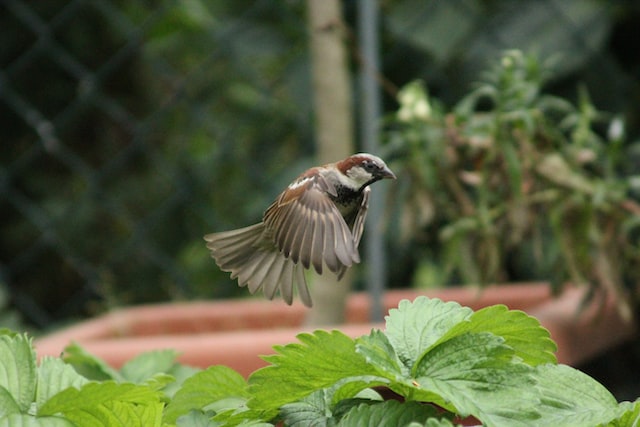
Best Time to Apply Bird Deterrent Methods
The optimal timing for implementing avian repelling techniques to ensure the safety of the fruiting crop is a crucial consideration for growers.
Ideally, it is best to start bird deterrent methods before the strawberry plants start to produce fruit.
This allows the birds to learn that the area is not a reliable food source, and they will be less likely to return later in the season when the fruit is ripe.
One effective method of bird control is the use of nylon netting. Growers can drape the netting over the strawberry plants, creating a barrier that birds cannot penetrate.
The netting should be stretched taut and secured to the ground to prevent birds from sneaking underneath.
Alternatively, growers can try placing paper bags over individual strawberries or employing predator effigies, such as owls or snakes, to scare the birds away.
Regardless of the method used, early implementation is key to a successful harvest.
Frequently Asked Questions
What other types of animals besides birds can damage strawberry plants?
Strawberry plants are vulnerable to a variety of animals besides birds, which can cause significant damage if left unchecked.
For instance, rodents such as mice and voles can gnaw on the stems and roots of the plants, leading to stunted growth or even death.
Slugs and snails can also be a problem, as they feed on the leaves and fruits of the plants, leaving unsightly holes and damaging the quality of the harvest.
Additionally, deer and rabbits are known to graze on strawberry plants, often consuming the entire plant in a single feeding.
Therefore, it is important to not only protect strawberry plants from birds but also to take measures to deter other animals that may cause harm to the plants.
Are there any bird species that are not deterred by common bird deterrent methods?
Certain bird species have been known to evade common bird deterrent methods used to protect strawberry plants.
These species may include larger birds such as crows or ravens, which are less intimidated by visual or auditory deterrents.
Additionally, some species may have developed a tolerance to certain chemicals used in bird repellents.
It is important to research the specific species of birds in the area and tailor the deterrent methods accordingly.
Alternative methods such as netting or physical barriers may also be effective in deterring birds that are not deterred by traditional methods.
It is imperative to continuously research and implement innovative techniques to effectively protect strawberry plants from bird damage.
How often should bird deterrent methods be applied to strawberry plants?
Proper maintenance of bird deterrent methods is crucial for the protection of strawberry plants.
The frequency at which these methods should be applied is dependent on various factors, including the type of deterrent used, the intensity of bird activity in the area, and the size of the strawberry patch.
A good rule of thumb is to monitor the effectiveness of the deterrents and apply them as needed, which may range from daily to every few days.
It is essential to rotate different types of bird deterrents to prevent birds from becoming accustomed to a specific method and to keep them guessing.
As such, regular and consistent application of bird deterrents is vital for ensuring the protection of strawberry plants from bird damage.
Can bird netting be used on other types of fruit plants besides strawberries?
Bird netting is a common bird deterrent method used to protect fruit plants from bird damage. While it is commonly used on strawberry plants, it can also be used on other types of fruit plants, such as blueberries, raspberries, and blackberries.
The netting should be draped over the plants and secured tightly to prevent birds from getting underneath. It is important to make sure the netting is properly installed and maintained to ensure its effectiveness.
While bird netting can be an effective method for protecting fruit plants from birds, it is important to note that it may not be the best solution for every situation.
Factors such as the size of the area to be covered and the type of birds in the area should be taken into consideration when determining the best bird deterrent method.
Are there any potential negative effects on the environment or other wildlife from using bird deterrent methods?
Birds are important members of the ecosystem that provide valuable services such as pollination and pest control. However, they can also cause significant damage to crops, leading farmers to adopt various bird deterrent methods.
While these methods can be effective in protecting crops, they may also have negative effects on the environment and other wildlife.
For instance, bird netting can cause entanglement and suffocation of non-target species such as bats, reptiles, and small mammals.
Additionally, the use of chemical bird repellents can harm beneficial insects and soil microorganisms.
Therefore, it is crucial to carefully evaluate the potential impacts of bird deterrent methods and adopt those that are safe and sustainable for both crops and the environment.
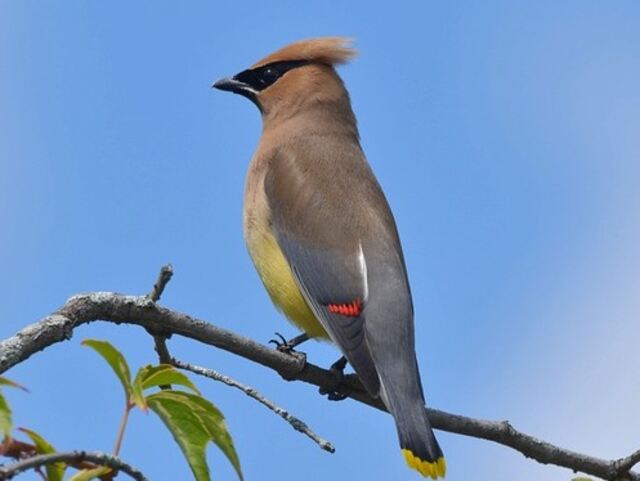
Conclusion
Birds can cause significant damage to strawberry plants, leading to decreased yields and poor quality fruit. It is essential to understand the types of birds that cause this damage and the most effective methods for keeping them away from the plants.
Several bird deterrent methods can be used, including physical barriers, netting, and scare devices. Natural methods such as using reflective surfaces or planting bird-repelling herbs can also be effective.
However, it is crucial to apply these methods at the right time, such as during the fruiting season.
By utilizing these methods, farmers and home gardeners can protect their strawberry plants from bird damage and ensure a healthy crop.
As the old adage goes, prevention is better than cure. By taking the necessary steps to protect strawberry plants from birds, farmers and gardeners can avoid the frustration and financial loss that comes with bird damage.
With patience and attention to detail, it is possible to keep birds away from strawberry plants and enjoy a bountiful harvest.
It is crucial to note that each method has its advantages and disadvantages, and farmers should select the one that suits their specific situation and needs.
Overall, protecting strawberry plants from birds is achievable with the right approach and commitment.

